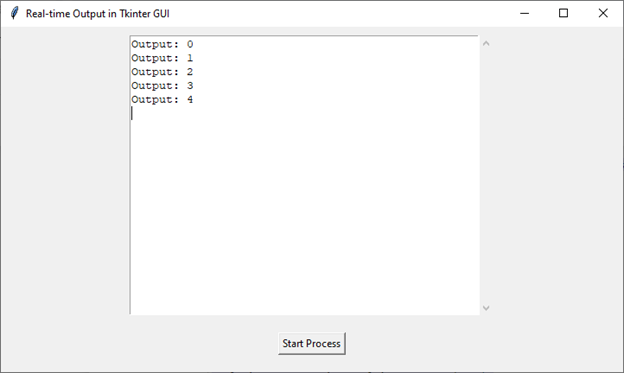
 Data Structure
Data Structure Networking
Networking RDBMS
RDBMS Operating System
Operating System Java
Java MS Excel
MS Excel iOS
iOS HTML
HTML CSS
CSS Android
Android Python
Python C Programming
C Programming C++
C++ C#
C# MongoDB
MongoDB MySQL
MySQL Javascript
Javascript PHP
PHP
- Selected Reading
- UPSC IAS Exams Notes
- Developer's Best Practices
- Questions and Answers
- Effective Resume Writing
- HR Interview Questions
- Computer Glossary
- Who is Who
Run process with realtime output to a Tkinter GUI
This tutorial explores the integration of real-time process output into a Tkinter GUI using Python. Tkinter helps in creating visually appealing interfaces, while the subprocess module facilitates the execution of external processes. By combining these two and incorporating threading for parallelism, developers can create responsive and interactive applications.
This tutorial outlines a practical example to illustrate the seamless integration of real-time output in Tkinter-based Python applications. Before getting into the code, let's briefly understand the key components involved in achieving real-time output in a Tkinter GUI.
Tkinter Tkinter is Python's de facto standard GUI (Graphical User Interface) package. It provides tools for creating visually appealing and interactive user interfaces.
The subprocess Module Python's subprocess module allows us to spawn new processes, connect to their input/output/error pipes, and obtain their return codes.
Example
Let's walk through a simple example to demonstrate running a process with real-time output in a Tkinter GUI. For this illustration, we'll use a basic scenario where a command-line process generates continuous output.
import tkinter as tk
from tkinter import scrolledtext
import subprocess
from threading import Thread
class RealTimeOutputGUI:
def __init__(self, root):
self.root = root
self.root.title("Real-time Output in Tkinter GUI")
root.geometry("720x250")
# Create a scrolled text widget for real-time output
self.output_text = scrolledtext.ScrolledText(root, wrap=tk.WORD, height=20, width=50)
self.output_text.pack(padx=10, pady=10)
# Button to start the process
self.start_button = tk.Button(root, text="Start Process", command=self.start_process)
self.start_button.pack(pady=10)
def start_process(self):
# Disable the button to prevent multiple process launches
self.start_button['state'] = tk.DISABLED
# Launch the process in a separate thread
process_thread = Thread(target=self.run_process)
process_thread.start()
def run_process(self):
# Command to simulate a process with continuous output
command = ["python", "-u", "-c", "for i in range(5): print('Output:', i); import time; time.sleep(1)"]
# Use subprocess to run the command
process = subprocess.Popen(command, stdout=subprocess.PIPE, stderr=subprocess.STDOUT, text=True, bufsize=1)
# Read and display real-time output in the GUI
with process.stdout:
for line in iter(process.stdout.readline, ''):
self.output_text.insert(tk.END, line)
self.output_text.yview(tk.END)
self.root.update()
# Enable the button after the process completes
self.start_button['state'] = tk.NORMAL
# Create the Tkinter root window
root = tk.Tk()
# Instantiate the RealTimeOutputGUI class
real_time_output_gui = RealTimeOutputGUI(root)
root.mainloop()
Understanding the Code Structure
Let's dissect the code structure to comprehend how the Python script orchestrates the interaction between Tkinter, subprocess, and threading.
Tkinter Setup We start by setting up a basic Tkinter GUI with a scrolled text widget for displaying real-time output and a button to initiate the process.
The start_process Method This method is called when the user clicks the "Start Process" button. It disables the button to prevent multiple process launches and initiates a new thread to run the process.
The run_process Method This method defines the actual process that will be executed. In this example, we use a subprocess to run a Python command that generates continuous output. The real-time output is read line by line and displayed in the Tkinter GUI.
Thread Usage We use the Thread class from the threading module to run the process in a separate thread. This ensures that the GUI remains responsive while the process is running.
Updating the GUI To display the real-time output in the Tkinter GUI, we use the insert method of the ScrolledText widget. Additionally, the yview method is called to keep the scrollbar at the bottom, ensuring that the latest output is always visible. The update method is used to refresh the GUI during the process execution.
Output
On running this code, you will get the following output window

Conclusion
In conclusion, the integration of real-time output into Tkinter GUIs, as demonstrated in this tutorial, enhances the user experience across various Python applications. By combining Tkinter for graphical interfaces, subprocess for executing external processes, and threading for parallel execution, developers can create responsive, interactive tools.

